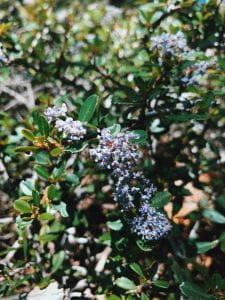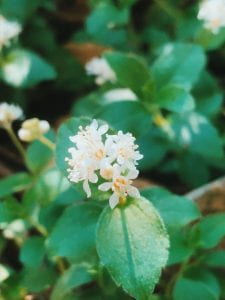On April 25th, our class returned to Mt. Tamalpais, this time beginning our elevational transect and hiking from Middle Peak to Pantoll. The drive to Mt. Tamalpais was about 40 minutes from campus. A diversity of habitats and communities were present in our hike, ranging from serpentine rocky outcrops, grasslands, and forests. Mt. Tamalpais hosts a wide range of wildlife such as lizards, snakes, birds, etc.
The first mystery species we came across was the Common bluecup (Githopsis specularioides), which is an annual herb native to California that belongs to the Campanulaceae family. The leaves of the Common bluecup are lanceolate-oblong in shape with entire margins, tapered bases, and acute apices. Both the leaves and stem are ciliate. The flower consists of 5 bright purple petals with white bases as well as 5 framing sepals whose length extends that of the petals. The flower is widely bell-shaped and is bilaterally symmetrical. A white, 3-lobed stigma is present in the center of the flower. The Common bluecup prefers to grow on slopes in both non-wetlands and wetlands.
The second mystery species we saw is Viola praemorsa subsp. linguifolia, which is a perennial herb native to California. This violet generally grows low to the ground with its height ranging from 11 to 30 cm. This plant has petioled, pubescent basal and cauline leaves. The leaves are elliptic-ovate in shape with tapered-chordate bases and acute apices. The margins of the blade are revolate-minutely dentate. The leaves are also pinnately veined with slightly reticulate tertiary veins. The flower consists of 5 bright yellow petals with purple-brown lines on the lower petal. Generally this violet prefers to grow in moist soil in forests, slopes, and meadows.
We also observed Buckbrush (Ceanothus cuneatus) is a flowering shrub that is native to California and belongs to the Rhamnaceae family. Its leaves are evergreen, oppositely arranged, and sessile. Buckbrush is the most widespread Ceanothus species in California. In the individual pictured, the margins of the blades are entire but the margins can be dentate in other individuals. The shape of the leaves is elliptic-oblong; the apices of the leaves are rounded. The color of the flowers of Buckbrush is variable and can range from white to blue to lilac. The inflorescence is umbel-like and consists of small, conspicuous flowers. Buckbrush can be found in a variety of communities, especially chaparral. Interestingly, Native Americans ate the seeds and brewed a tea from the leaves to treat fevers and coughs. The buckbrush also produces a musky scent and its roots can be used to make red dye.
Trip Summary: In the city it was windy and chilly so I thought I would be fine in a sweater. Once we crossed the bridge the weather changed drastically and was actually very warm. As we trekked through the hot open space, I found myself desperate for the next tree to provide any bit of shade. In the distance we could see Karl the fog blanketing the city and it was a rare occasion that I wished for it to come our way. I don’t want to complain about the trip too much because overall it was a beautiful hike and it was really interesting to see the harsh reality of serpentine living up close. We even got to see a bunch of lizards, a snake, and some puff mushrooms!
Honorable Mention Species














